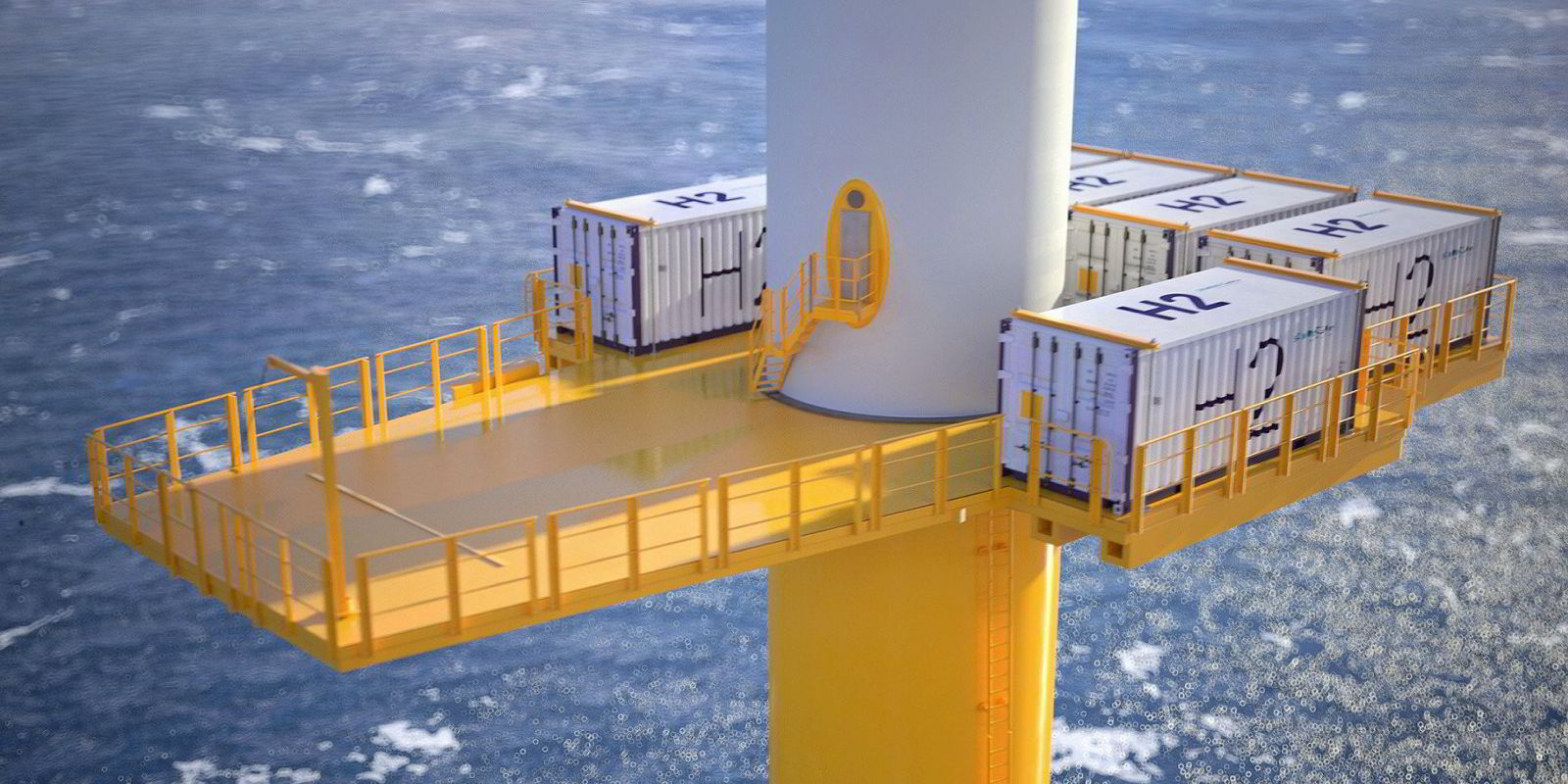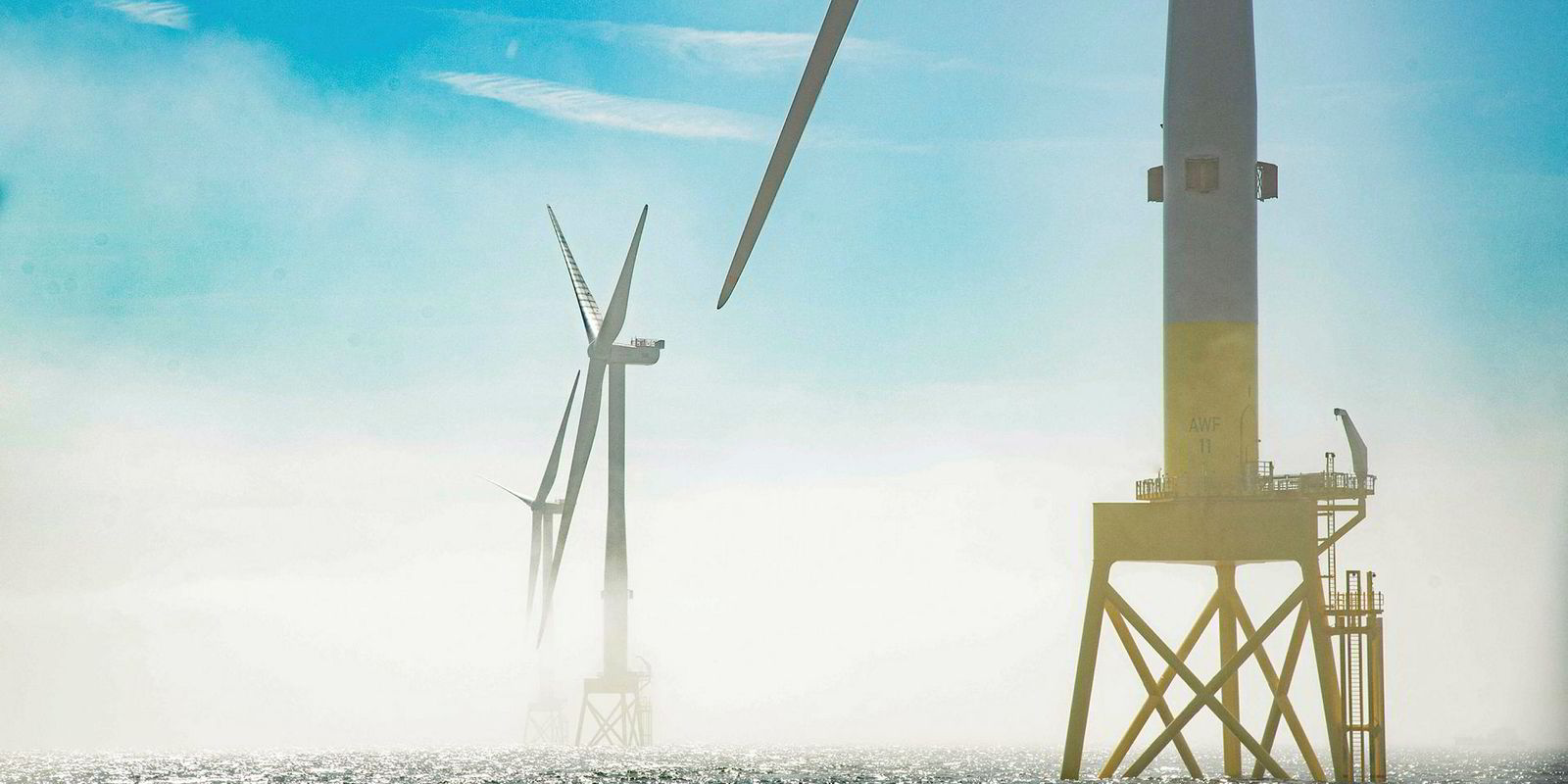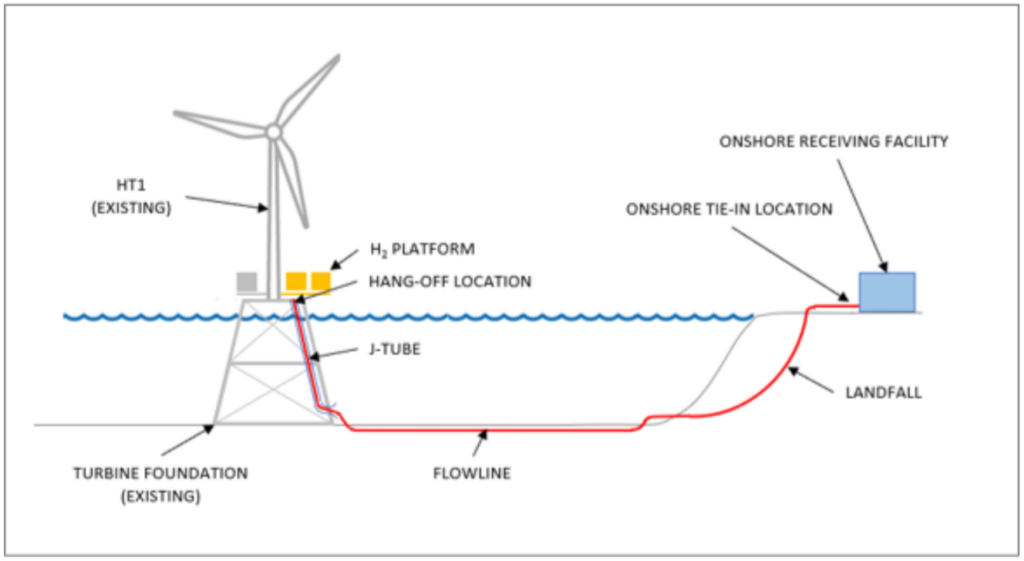Swedish group draws up plans to fit electrolyser to Vestas machine at EOWDC off Aberdeen

First Minister of Scotland, Nicola Sturgeon attends the opening of The European Offshore Wind Deployment Centre located in Aberdeen Bay in 2018 in Aberdeen.
Photo: Jeff J Mitchell/Getty Images/Getty Images
6 January 2022
By Andrew Lee
By Andrew Lee
Vattenfall could be poised to test on-turbine green hydrogen production at its experimental wind farm off Aberdeen, Scotland.
The Swedish group has drawn up plans to fit an electrolyser and associated equipment such as desalination in containerised modules fitted to the transition piece of one of the 11, 8MW-plus Vestas turbines at the European Offshore Wind Deployment Centre (EOWDC), with the H2 to be sent ashore via a flowline to an offtake point on land.

Cable free: work starts on pipes to ship hydrogen – not power – from Siemens Gamesa wind turbinesRead more
“The project offers a unique opportunity to test the viability of offshore production of green hydrogen and help move towards commercial scale operations and the associated positive environmental benefits that come from this,” Vattenfall said in a scoping report submitted to Scottish authorities.
Vattenfall switched on the EOWDC in 2018 after a years-long legal battle with former US President Donald Trump, who objected to the impact of the turbines on views from his luxury golf course.
Offshore production of green H2 is a hot topic in the emerging renewable hydrogen sector, with work underway by the likes of Siemens Gamesa to integrate electrolysis with turbines and several initiatives to site production on platforms taking power from nearby wind arrays.
 \
\Making offshore wind great againRead more
One of the biggest advantages foreseen is the potential to create self-contained H2 production arrays offshore, with hydrogen rather than electricity shipped ashore – removing the need for costly power infrastructure altogether.
The North Sea off Aberdeen is already home to another green H2 technology initiative in the form of Dolphyn, which eventually hopes to deploy gigawatt-scale green hydrogen production on floating wind platforms off northern Scotland.
Read more
'Our vision is to replace offshore oil & gas': inside the all-Siemens push for the hydrogen wind turbine
RELATED NEWS
Subsea caverns to store hydrogen from gigawatt-scale wind farms in 'world first' plan by Engie unit
Energy Transition
20 December 2021 12:37 GMT
Salamander floating wind project off Scotland gets gassed up with new-look hydrogen kit
Energy Transition
4 August 2021 7:41 GMT
World's largest floating wind farm to power landmark green hydrogen project
Transition
28 September 2020 13:51 GMT
Vattenfall Working on Hydrogen Demo Project at Aberdeen Offshore Wind Farm
January 5, 2022, by Adrijana Buljan
Vattenfall is working on a hydrogen demonstrator project named Hydrogen Turbine 1 (HT1), which involves installing hydrogen production equipment on one of the wind turbines at its Aberdeen Offshore Wind Farm (European Offshore Wind Deployment Centre) in Scotland.
The company has already submitted a couple of applications for pipeline route surveys with Marine Scotland, as well as an Environmental Impact Assessment (EIA) Screening Opinion Request accompanied by a report.
As we reported at the beginning of December 2021, Vattenfall contracted Fugro to carry out a geoscience survey and subsequent data processing and reporting for a proposed hydrogen pipeline route connecting its European Offshore Wind Deployment Centre (EOWDC) and Aberdeen Port.
Vattenfall Surveying Hydrogen Pipeline Route at EOWDC
According to the application documents filed with Marine Scotland, the developer submitted its first application for a pipeline route survey in August 2021 and then applied for the same work to be carried out at an additional route on 14 December (application document dated 17 November 2021).
The Hydrogen Turbine 1 Project
The HT1 project would retrofit one of the offshore wind farm’s existing turbines by installing an extended transition piece platform to house hydrogen production equipment. The hydrogen-producing wind turbine would be connected to an onshore storage and offtake facility by a subsea flowline transporting green hydrogen to the shore.

January 5, 2022, by Adrijana Buljan
Vattenfall is working on a hydrogen demonstrator project named Hydrogen Turbine 1 (HT1), which involves installing hydrogen production equipment on one of the wind turbines at its Aberdeen Offshore Wind Farm (European Offshore Wind Deployment Centre) in Scotland.
The company has already submitted a couple of applications for pipeline route surveys with Marine Scotland, as well as an Environmental Impact Assessment (EIA) Screening Opinion Request accompanied by a report.
As we reported at the beginning of December 2021, Vattenfall contracted Fugro to carry out a geoscience survey and subsequent data processing and reporting for a proposed hydrogen pipeline route connecting its European Offshore Wind Deployment Centre (EOWDC) and Aberdeen Port.
Vattenfall Surveying Hydrogen Pipeline Route at EOWDC
According to the application documents filed with Marine Scotland, the developer submitted its first application for a pipeline route survey in August 2021 and then applied for the same work to be carried out at an additional route on 14 December (application document dated 17 November 2021).
The Hydrogen Turbine 1 Project
The HT1 project would retrofit one of the offshore wind farm’s existing turbines by installing an extended transition piece platform to house hydrogen production equipment. The hydrogen-producing wind turbine would be connected to an onshore storage and offtake facility by a subsea flowline transporting green hydrogen to the shore.

Source: Vattenfall’s EIA Screening Opinion Request Report
The company detailed on the HT1 project in the screening report, saying that the transition piece of the B06 turbine at EOWDC would be fitted with a platform which would provide sufficient area for the installation of an electrolyser, desalination equipment, and compressors, housed in up to seven separate shipping containers with additional cooling where required.
A new J-tube would be installed to route the flowline from the transition piece to the seabed, and extraction and discharge pipes would extend from the equipment into the water column.
The hydrogen transmission system from the B06 offshore wind turbine to the onshore storage facility is expected to consist of a single flexible flowline, from the hang-off location on the turbine foundation to the onshore tie-in location.
Aberdeen Offshore Wind Farm, or the European Offshore Wind Deployment Centre (EOWDC), has been operational since 2018 and it is Scotland’s largest offshore wind test and demonstration facility.
The offshore wind farm comprises eleven Vestas 8.8 MW wind turbines installed on suction bucket foundations.
The company detailed on the HT1 project in the screening report, saying that the transition piece of the B06 turbine at EOWDC would be fitted with a platform which would provide sufficient area for the installation of an electrolyser, desalination equipment, and compressors, housed in up to seven separate shipping containers with additional cooling where required.
A new J-tube would be installed to route the flowline from the transition piece to the seabed, and extraction and discharge pipes would extend from the equipment into the water column.
The hydrogen transmission system from the B06 offshore wind turbine to the onshore storage facility is expected to consist of a single flexible flowline, from the hang-off location on the turbine foundation to the onshore tie-in location.
Aberdeen Offshore Wind Farm, or the European Offshore Wind Deployment Centre (EOWDC), has been operational since 2018 and it is Scotland’s largest offshore wind test and demonstration facility.
The offshore wind farm comprises eleven Vestas 8.8 MW wind turbines installed on suction bucket foundations.
No comments:
Post a Comment